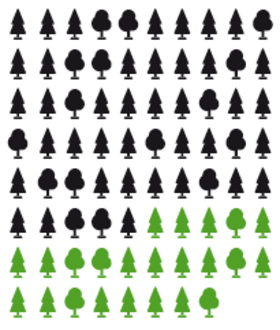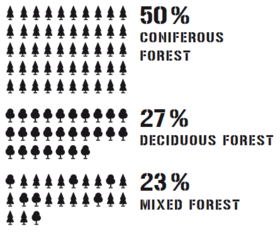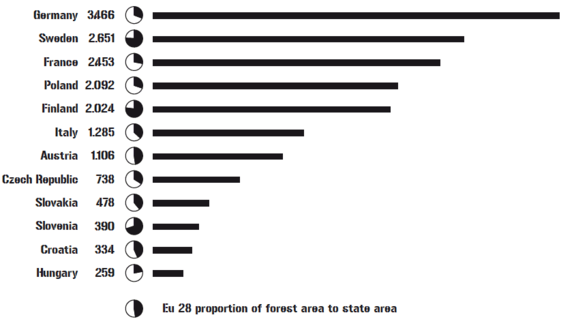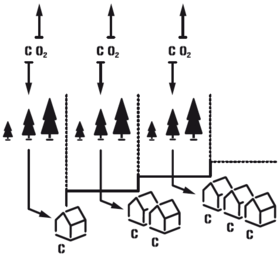Content
Tonnes of CO2
Cars, aeroplanes and people – all of them produce CO2.
Austria’s transport sector is responsible for the third highest level of carbon dioxide emissions in the EU. Every single Austrian produces 2,515 kg of harmful emissions in this area.
| Use of a car for one year (11,400 kilometres) | 1,5 tonnes CO2 |
| Flight Milan – New York – Milan | 1,5 tonnes CO2 |
Energy use in a three-person | 2,5 tonnes CO2 |
| Oil heating (2,000 litres/year) | 5,6 tonnes CO2 |
Available Forest

Less than two-thirds of volume of wood grown annually is used in Europe.
Every year, 776 million cubic metres of wood is grown in Europe. But only 490 million cubic metres is harvested each year. The remaining 286 million cubic metres remains in forests and thereby increases the total European forest area every single year. In Austria, less than a third of the annual wood growth would suffice to construct all of the buildings erected in one year using wood.
Cultivated Forests
Managed forests provide a greater potential for reducing carbon emissions.
European forests have been sustainably managed for over 250 years. One of the strictest forestry laws in the world provides the framework for managing forests in Austria. The foremost principle is that no more trees may be harvested than are regrown. In contrast to an unmanaged forest, in which carbon absorption and carbon emission balance one another out over the long term, trees are removed from managed forests before they begin to rot and release carbon dioxide.
1 m³ wood stores 1 tonne CO2
Using wood to make things is a means of extending its potential as a carbon sink.
The WOODBOX is made from 22 m³ of wood. The amount of stored carbon dioxide is equal to the amount that a modern car emits over the course of driving 180,000 km. Wood can spare the atmosphere extra carbon dioxide for decades. This is why we should find ways to use wood as a practical material and prevent its being used in energy production for as long as possible.
The European Forest

Conifer forests predominate in Europe.
Half of all European forests are conifer forests. A further 27% are deciduous forests. The remaining 23% may be classified as mixed forests.
A wall made from CO2
Different building materials have different carbon footprints.
Houses made from wood are not simply enormous carbon sinks that have been relocated from the forest. They also contribute to the reduction of carbon dioxide in other areas. Wood replaces common building materials such as bricks or concrete, the production of which is carbon intensive. The related emissions are thereby avoided through the use of wood.
| 1 m³ conventional exterior wall: | Solid wood | – 88kg CO2 |
| Wooden frame | – 45kg CO2 | |
| Bricks | + 57kg CO2 | |
| Concrete | + 82kg CO2 |
Existing Inventory

Wood is plentiful in Europe.
There are 3,466 million cubic metres of timber stock in Germany. This puts it at the top of the list among European countries. Austria has 1,106 million cubic metres and occupies a middle position in the rankings. If one compares the area covered by forest to a country’s entire land mass, then the Scandinavian countries Sweden and Finland come out ahead.
Wood is recyclable
In contrast to other materials, wood can be easily recycled.
Compared to other building materials made from unsustainable raw materials, wood materials are recyclable products that save resources. There is no elaborate disposal process for wood as a building material – in the end, it can be used as a source of energy and thereby can replace fossil fuels such as coal, oil or natural gas. Burning wood only releases the same amount of carbon that was absorbed before.
Wood – poorly utilised but not dead yet

Houses made of wood store carbon dioxide and help to protect the environment.
Every trunk that is used from the forest frees up space for new trees. While products made of wood store carbon dioxide, enough wood grows in the forests to replace the wood taken to make those products and this wood continues to actively absorb carbon dioxide from the atmosphere. Wood has a dual positive impact on carbon footprints as a raw material and building material since carbon remains stored in it for the entirety of its life cycle as a product.
Living with and from wood
Wood provides employment to many people.
Some 3.5 million people work in the forestry and wood industries in Europe. That is almost as many as those working in the car industry. In Austria about 280,000 people make their living from forests and wood. And since this is a raw material and building material that continues to grow, the number of jobs grows too.
Carbon Footprint
A carbon footprint is a measure of the volume of carbon dioxide emitted into the atmosphere as a result of particular activities, products or behaviours. The management of forest resources and the use of wood set a positive example in ensuring a small carbon footprint.
Forests absorb and store carbon dioxide (CO2), the management of forests provides the raw material of wood, products made of wood extend the storage of carbon dioxide and create the space for new forest growth. At the same time, they replace materials that emit carbon dioxide.
In figures: 250 kg C/m3 wood x 3.67 kg CO2 = 917 kg CO2
Wood is composed of up to 50 per cent carbon. One cubic metre of wood weighs 500 kilograms on average, which means it contains about 250 kilograms of carbon. When carbon is transformed into carbon dioxide (oxidised), 1 kg of carbon creates about 3.67 kg of CO2. Therefore 250 kg of carbon creates 917 kg of CO2, which is about 1 tonne of CO2 per cubic metre of wood. (Arno Frühwald, University of Hamburg)
